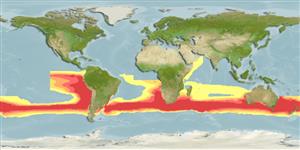>
Beloniformes (Needle fishes) >
Scomberesocidae (Sauries)
Etymology: Scomberesox: Latin, scomber = mackerel + Esox, the old name for "pike" (Ref. 45335); scombroides: From manuscript on Esox scombroides, Solander, 1772.
More on author: Richardson.
Environment: milieu / climate zone / depth range / distribution range
Ecologia
marinhas; estuarina; oceanódromo (Ref. 51243); intervalo de profundidade 0 - ? m. Subtropical
Atlantic, Indian and Pacific: generally circumglobal in temperate waters of the southern hemisphere. More common between 30°-40°S, but more northerly to 15°S near Africa and to near equator off Ecuador along South American west coast (particularly the young and juveniles). Highly migratory species.
Length at first maturity / Tamanho / Peso / Idade
Maturity: Lm 28.7, range 23 - 25 cm
Max length : 50.0 cm SL macho/indeterminado; (Ref. 6531)
Descrição breve
Chaves de identificação | Morfologia | Morfometria
Espinhos dorsais (total) : 0; Raios dorsais moles (total) : 10 - 12; Espinhos anais: 0; Raios anais moles: 12 - 14; Vértebras: 64 - 68. Presence of toothless bill-like jaws, and finlets posterior to the dorsal and anal fins.
An epipelagic, gregarious species. Occurs in surface waters of the open sea; occasionally enters bays and inlets (Ref. 9563). Flesh is highly esteemed (Ref. 6617) but large schools are too sporadic to be of commercial importance (Ref. 6531). Feeds on small planktonic organisms, preyed upon by yellowfin tuna, Cape gunnets, marine mammals. Migrates from spawning areas to cool temperate and plankton-rich waters (Ref. 36731).
Wisner, R.L., 1990. Scomberesocidae. p. 598-603. In J.C. Quero, J.C. Hureau, C. Karrer, A. Post and L. Saldanha (eds.) Check-list of the fishes of the eastern tropical Atlantic (CLOFETA). JNICT, Lisbon; SEI, Paris; and UNESCO, Paris. Vol. 2. (Ref. 6531)
Categoria na Lista Vermelha da IUCN (Ref. 130435: Version 2024-1)
Ameaça para o homem
Harmless
Utilização humana
Pescarias: pouco comercial; isco: usually
Ferramentas
Relatórios especiais
Descarregue XML
Fontes da internet
Estimates based on models
Preferred temperature (Ref.
123201): 14.2 - 21.3, mean 18.2 °C (based on 1430 cells).
Phylogenetic diversity index (Ref.
82804): PD
50 = 0.6562 [Uniqueness, from 0.5 = low to 2.0 = high].
Bayesian length-weight: a=0.01122 (0.00514 - 0.02450), b=3.04 (2.87 - 3.21), in cm total length, based on all LWR estimates for this body shape (Ref.
93245).
Nível Trófico (Ref.
69278): 4.1 ±0.3 se; based on diet studies.
Resiliência (Ref.
120179): Médio, tempo mínimo de duplicação da população 1,4 - 4,4 anos (tm=3).
Fishing Vulnerability (Ref.
59153): Moderate vulnerability (44 of 100).
